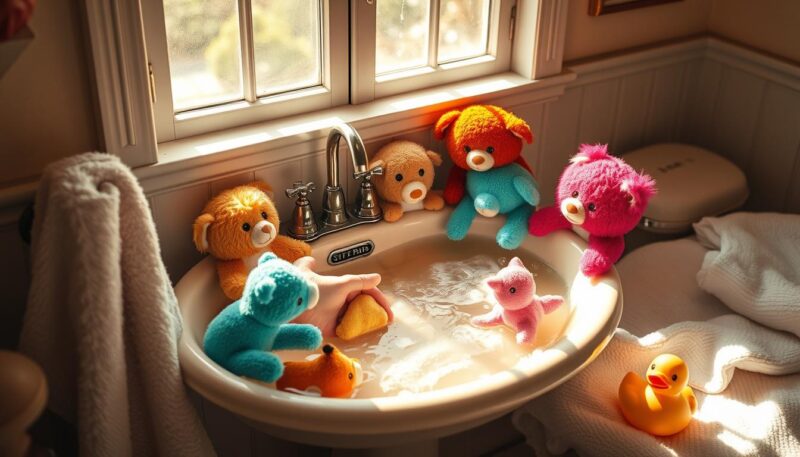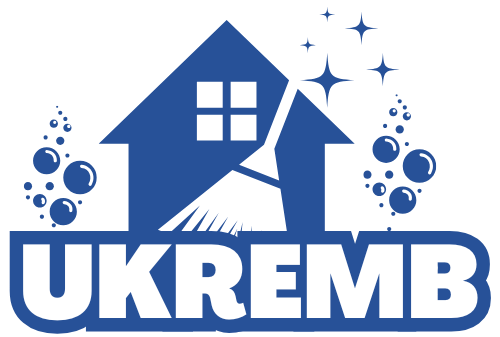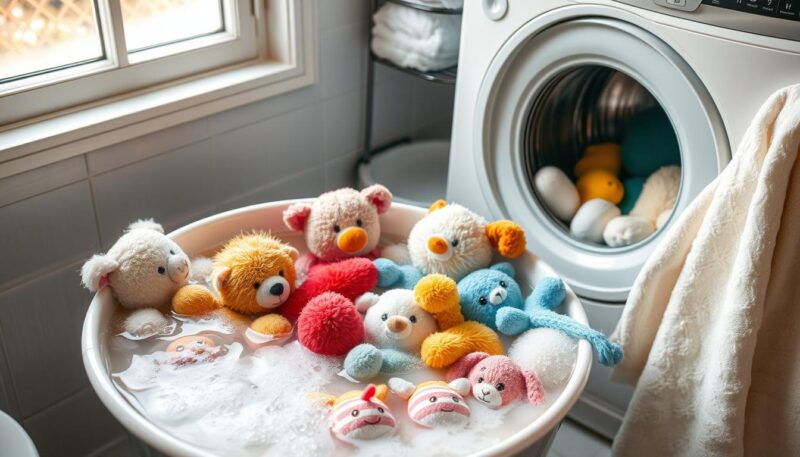Stuffed animals hold a special place in your child’s heart, providing comfort and companionship, but they can also become hotspots for dust, germs, and spills. Understanding how to wash stuffed animals without ruining them is essential for maintaining their longevity and hygiene. In fact, it’s recommended that you wash 1 out of every 5 stuffed animals on a weekly basis, especially if your child sleeps with them. By utilizing correct washing methods—either through hand wash or machine wash—you can ensure their beloved plush toys remain clean and safe to cuddle. Always start by checking the care tag to see any specific cleaning instructions from the manufacturer, and consider doing a color test on a less visible area to prevent any unwanted surprises. Whether it’s a matter of allergies, illness, or just plain grubbiness, knowing how to clean stuffed animals effectively will not only keep them looking new but also promote a healthy environment for your little one.
Understanding the Importance of Cleaning Stuffed Animals
Regular cleaning of stuffed animals holds significant importance for both health and comfort. These beloved toys often become breeding grounds for germs on stuffed toys if neglected. You may be surprised to discover how quickly dust mites, pet dander, and bacteria accumulate on the surface, impacting not only the toy’s appearance but also your child’s health. Establishing a routine for cleaning stuffed animals will go a long way in keeping them soft and hygienic.
Why Regular Cleaning is Necessary
Understanding the relevance of cleaning stuffed animals is essential for maintaining a healthy environment. Germs on stuffed toys can lead to allergic reactions or immune responses. To keep these cherished toys safe for your child, aim to wash them at least once a month. Frequent inspections for visible signs of wear, such as odors or stains, will help you decide when to increase the cleaning frequency for plush friends that might need more attention.
When to Consider Washing
Certain circumstances warrant immediate action regarding the cleanliness of stuffed animals. If your child has been ill, it’s crucial to thoroughly wash any comfort toys they have used. Seasonal allergies also indicate a need for more regular cleaning to ensure your little ones are not affected by allergens that can linger on their toys. Establishing a cleaning schedule provides the opportunity to maintain the importance of cleaning stuffed animals while ensuring that they remain soft and inviting for cuddles and playtime.
How to Wash Stuffed Animals Without Ruining Them
Cleansing your child’s beloved stuffed animals is essential, especially given that over 71% of children have a favorite plush toy. Ensuring cleanliness not only maintains the toy’s appearance but also contributes to your child’s health. The best approach often boils down to a choice between hand wash vs machine wash toys. Each method has its advantages and ideal use cases, particularly when it comes to cleaning delicate toys.
Choosing Between Hand Wash vs. Machine Wash
Understanding the particular needs of each stuffed animal helps in deciding the washing method. Approximately 65% of stuffed animals crafted today boast machine-washable labels, making machine washing a popular choice among parents. This technique accounts for about 55% of parental cleaning preferences, thanks to its effectiveness and convenience. In contrast, hand washing may be necessary for delicate toys or those with unique components that could be damaged in a machine.
Machine Washing Stuffed Animals
For machine washing, following the manufacturer’s care instructions is critical. Place the stuffed animal in a mesh bag to protect it and opt for a gentle cycle with a mild detergent like Clorox Fabric Sanitizer. While machine washing serves as an efficient way to clean stuffed animals, it is essential to note that tumble drying might cause 6% of plush toys to incur damage. Therefore, air drying is recommended. About 78% of specialists advise air drying because it eliminates heat exposure, which can be detrimental to plush toys.
Hand Washing Stuffed Animals
When you choose to hand wash, it is crucial to ensure that you’re thoroughly cleaning delicate toys without compromising their integrity. Fill a basin with cold water, mixing in a mild detergent. Gently agitate the stuffed animal and avoid wringing, which could distort its shape. This method might not disinfect as effectively as machine washing, yet it remains vital for fragile toys or those containing components like plastic pellets or batteries. Using baking soda on toys that can’t be submerged in water offers another cleaning alternative, though it does not guarantee disinfection.

| Cleaning Method | Pros | Cons |
|---|---|---|
| Machine Washing |
|
|
| Hand Washing |
|
|
Ultimately, both methods aim to achieve the same goal: maintaining the charm and safety of children’s toys while promoting a hygienic play environment.
Conclusion
Maintaining the cleanliness of stuffed animals is essential for nurturing your child’s health and ensuring that these cherished toys stay vibrant and cuddly. By understanding and employing safe cleaning methods for stuffed animals, you can effectively eliminate dirt and germs while preserving their condition and charm. Regular washing, at least every two to three months, is vital, especially if the toys have visible dirt, unpleasant odors, or are frequently used by sensitive children.
Adopting the best practices for washing toys not only promotes hygiene but also extends the lifespan of these beloved companions. Incorporating simple routines, such as spot cleaning, using mild detergents, and following care instructions, will go a long way in providing a safe environment for your child to play. For delicate items, hand-washing remains the safest option, while machine washing can be appropriate for many plush toys.
Ultimately, the goal is to ensure that your child’s stuffed animals remain inviting while safeguarding their health. Remember, consistent cleaning plays a significant role in maintaining both the quality and softness of these treasured friends, allowing them to continue to offer comfort and joy for years to come.

